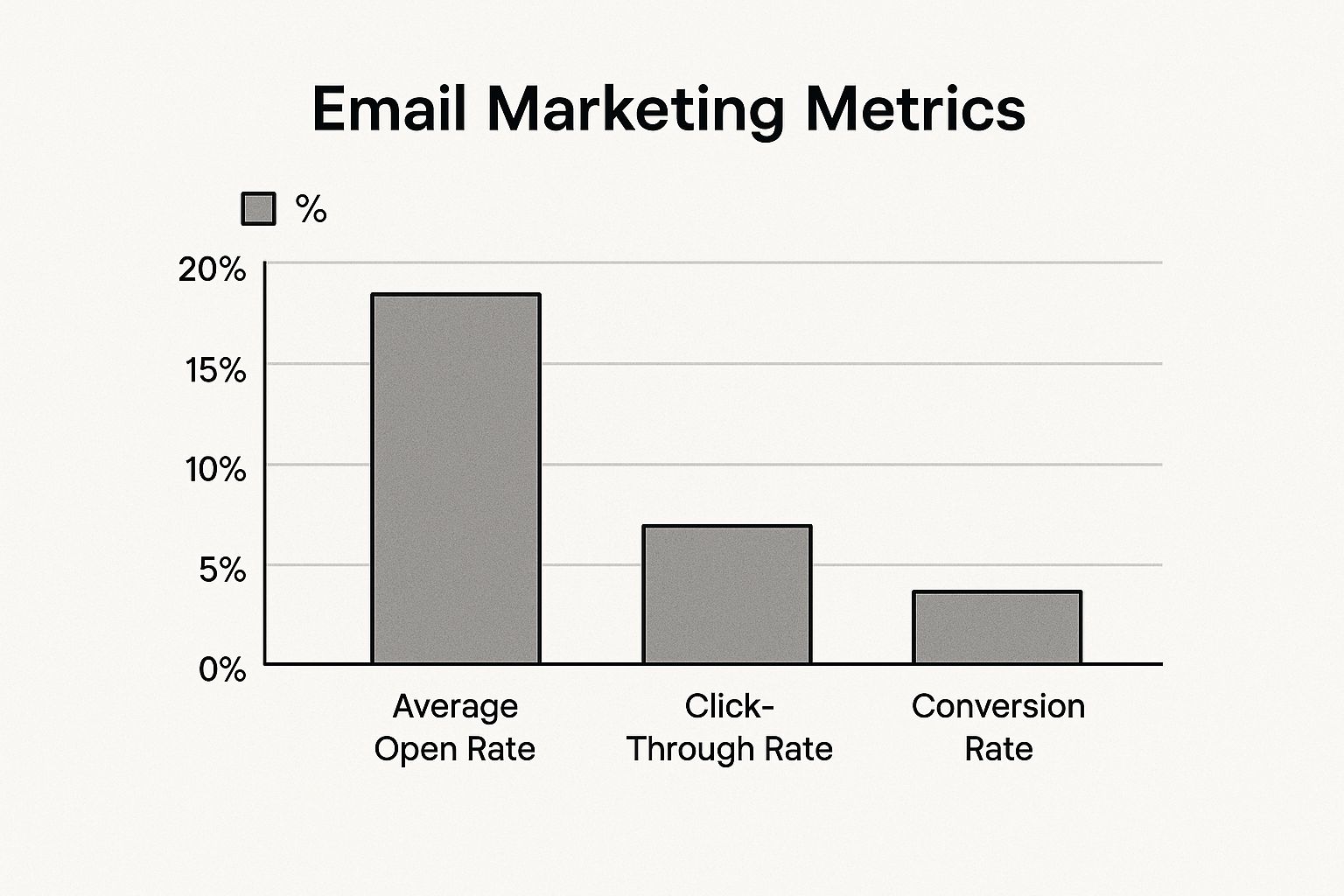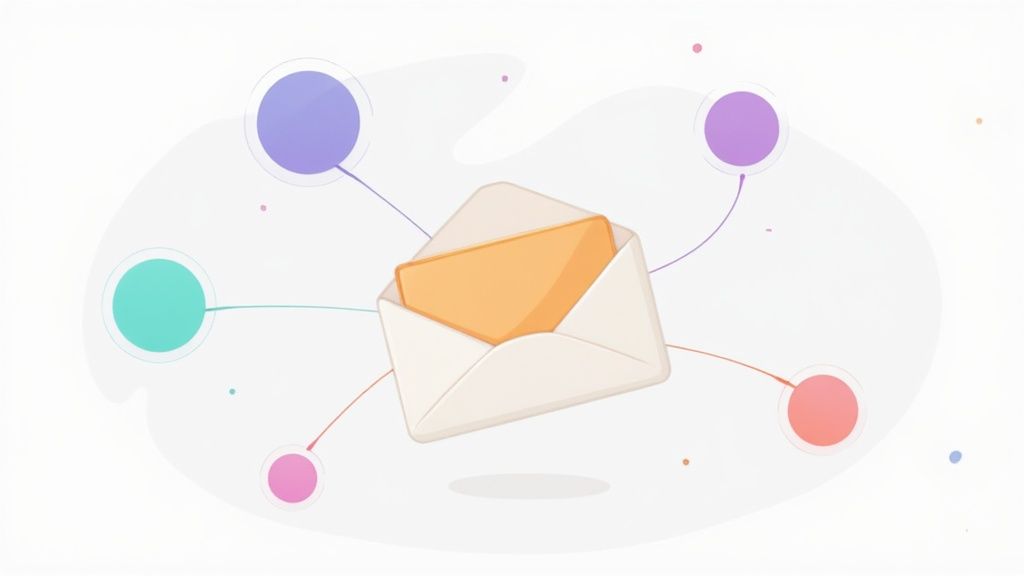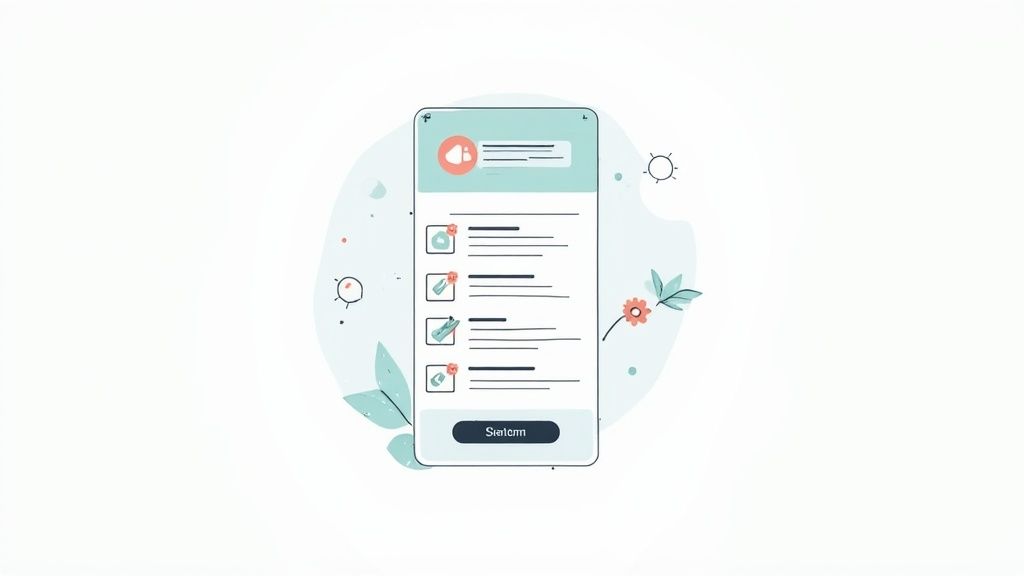Understanding the Science of Email Marketing Conversion Rates
Email marketing isn’t just about sending messages; it’s about prompting action. Email marketing conversion rates are the key metric that reveals how effectively your emails are converting readers into customers, subscribers, or event attendees—whatever your desired outcome. This section explores the core principles of understanding and improving these critical metrics.
Defining Email Marketing Conversion Rates
Your email marketing conversion rate is simply the percentage of people who complete a desired action after clicking a link in your email. This could be anything from purchasing a product to downloading a helpful resource. For example, if you send an email to 1,000 subscribers promoting a new product, and 50 make a purchase after clicking through, your conversion rate is 5% (50/1,000 * 100). Understanding this fundamental calculation is the first step towards harnessing its power.
Industry Benchmarks and Trends
Understanding how your email marketing conversion rates compare to the competition is essential. Email marketing has consistently delivered impressive conversion rates. In 2021, the average conversion rate was around 15.2% for those who clicked through. This means roughly one in six people who engaged with an email completed the desired action. This rate reached a high point in 2018, exceeding 18.4%, but has seen a slight decline since then. The effectiveness of email conversions demonstrates the value of email marketing as a direct sales driver, with nearly 50% of consumers making purchases directly through email in recent years. For more detailed statistics, visit: Learn more about email marketing statistics. To further explore tactics to boost your rates, consider this resource: Boost Your Sales: Improve Ecommerce Conversion Rate.
The following data chart illustrates average email marketing conversion rates across different industries, offering valuable benchmarks for your campaigns.

As the chart reveals, e-commerce and travel see higher conversion rates, likely due to the direct transactional nature of their email campaigns.
To better understand how your conversion rates stack up, let’s examine industry benchmarks in more detail. The following table presents a comparison of average email conversion rates across various sectors.
Email Conversion Rate Benchmarks by Industry
A comparison of average email conversion rates across different industry sectors
| Industry | Average Conversion Rate | Top Performer Rate | Click-to-Conversion |
|---|---|---|---|
| E-commerce | 2.5% | 5% | 12% |
| SaaS | 1.8% | 3.5% | 8% |
| Travel | 3.2% | 6% | 15% |
| Non-profit | 1.5% | 3% | 10% |
This table highlights key differences and similarities in conversion rates across industries. While e-commerce and travel typically enjoy higher rates, SaaS businesses, despite lower averages, still show significant potential for optimization, as demonstrated by their top performers. Understanding your industry benchmark is essential for setting realistic goals and gauging success. It also underscores the opportunity to surpass the average and strive for top-performer status.
Unlocking the Revenue Potential of Automated Email Sequences
Automated email sequences are more than just scheduled emails; they’re a powerful engine for driving conversions. Think of them as a tireless sales team, working around the clock to guide each prospect through their unique buying journey. This personalized, scalable approach is why automated campaigns consistently outperform traditional email blasts by a factor of 4-5x. Want to boost your revenue? Delving into automated email sequences can be a game-changer. For a deeper dive into how this works for affiliate marketing, check out this resource: email marketing for affiliates.
The Psychology Behind High-Converting Triggers
The key to effective automated sequences lies in understanding behavioral triggers. These triggers represent pivotal moments in the customer journey where a well-timed, relevant email can make all the difference. An abandoned cart email, for instance, gently nudges a shopper back to their forgotten items, often sweetening the deal with an incentive. Similarly, welcome emails greet new subscribers, setting the stage for a positive relationship. This proactive communication builds trust and guides prospects towards a conversion.
Building Responsive Workflows
Think of creating a responsive workflow like designing a choose-your-own-adventure for your subscribers. Based on their actions, the workflow branches into different paths, delivering the most relevant content at each stage. Imagine a prospect downloads a resource about email marketing conversion rates. This action could trigger a sequence focusing on advanced email strategies. But if they then click a link about social media marketing, the workflow seamlessly shifts into a sequence showcasing social media integration tips. This dynamic approach ensures personalized content for every subscriber.
Real-World Examples and Implementation Blueprints
Leading brands use automated sequences to create personalized journeys at scale. Consider a travel company that triggers an automated email sequence based on a flight search. The first email might include personalized destination guides and hotel recommendations. If the user books a flight, subsequent emails could offer travel insurance, car rentals, or suggestions for local activities. This targeted approach not only improves the customer experience but also maximizes revenue opportunities. Automated email campaigns have become incredibly effective at driving conversions. In 2024, automated emails generated an impressive 37% of all email-generated sales, despite representing just 2% of total email volume. Welcome emails achieved a conversion rate of nearly 3%, while cart abandonment emails saw around 2%. For more detailed statistics on email marketing performance, take a look at: Discover more insights about email marketing statistics.
To further illustrate the conversion power of different automated email types, let’s examine the following table:
“Conversion Performance of Automated Email Types”
“Statistics showing how different types of automated emails perform in terms of conversion rates”
| Email Type | Average Conversion Rate | Average Revenue Per Email | Implementation Difficulty |
|---|---|---|---|
| Welcome Email | 3% | $0.50 | Easy |
| Abandoned Cart Email | 2% | $2.00 | Medium |
| Post-Purchase Follow-up | 1% | $1.50 | Medium |
| Product Recommendation | 0.5% | $3.00 | Hard |
| Re-engagement Email | 0.2% | $0.75 | Medium |
This table clearly highlights the varying conversion rates and revenue potential of different automated email types. While welcome emails have a higher conversion rate, abandoned cart and post-purchase emails contribute significantly to revenue due to the higher value of the actions they encourage. Implementation difficulty also varies, with product recommendations requiring more sophisticated setup.
From Post-Purchase to Long-Term Engagement
Automated sequences don’t stop at the initial sale. Post-purchase follow-ups can gather feedback, offer related products, or invite customers to join a loyalty program. This ongoing engagement builds long-term relationships and increases customer lifetime value. By understanding the psychology of trigger scenarios and building responsive workflows, businesses can truly unlock the power of automated email sequences to boost their email marketing conversion rates.
Crafting Conversion-Focused Email Content That Resonates

The difference between an ignored email and a conversion often lies in the content. Understanding effective email copywriting is key to boosting your email marketing conversion rates. This section explores essential elements of compelling email content, from subject lines to calls to action.
The Power of a Compelling Subject Line
Your subject line is your first impression, the gateway to your email’s content. A strong subject line significantly improves open rates, the first step towards conversion. Using numbers or posing questions can pique interest. For instance, “5 Proven Ways to Boost Your Email Conversions” is far more engaging than “Email Marketing Tips.” Personalized subject lines contribute to a 26% increase in open rates.
Structuring Your Email for Success
Like a hotel lobby guiding guests to reception, your email should guide readers to the conversion point. Use clear headings, subheadings, and bullet points for easy scanning, especially for mobile users. Keep paragraphs short, focusing on one core message per email to avoid overwhelming readers.
Balancing Education and Persuasion
Effective emails balance information with persuasion. Like a helpful concierge offering advice while subtly highlighting amenities, provide valuable insights related to reader interests, then link these to your offer. This builds trust and makes conversion a natural next step. An email about conversion rates could offer advice on subject lines, then promote an email marketing tool. 59% of consumers say email marketing influences purchasing decisions.
Crafting a Powerful Call to Action
Your call to action (CTA) is the final push towards conversion. Keep it clear, concise, and action-oriented. Use strong verbs like “Download,” “Register,” or “Get Started” to create urgency. Ensure the CTA button is visually prominent and easily clickable, particularly on mobile.
Building Long-Term Engagement Through Value
Every email should offer value, even if not directly promotional. This builds engagement and fosters community. Share valuable resources, exclusive content, or behind-the-scenes insights to nurture relationships. This establishes your brand as a trusted resource, increasing the likelihood of future conversions and promoting repeat business through positive word-of-mouth.
Strategic Segmentation: The Conversion Rate Multiplier

Sending generic email blasts to your entire subscriber list isn’t the most effective strategy. It’s like casting a wide net and hoping for the best. Strategic segmentation, on the other hand, allows you to target specific groups with tailored messages, significantly increasing your email marketing conversion rates. Let’s explore the power of segmentation and how to implement it effectively.
Practical Approaches to Audience Segmentation
Imagine a clothing retailer sending the same promotion to everyone. A teenager interested in trendy streetwear won’t be interested in an email about professional attire. By segmenting their audience based on demographics and past purchases, the retailer can send relevant emails showcasing products that align with individual preferences. This leads to higher open rates, more click-throughs, and ultimately, better email marketing conversion rates.
There are several ways to segment your audience based on the data you have:
- Demographics: Age, gender, and location provide a foundational understanding of your audience.
- Behavior Patterns: Website activity, email engagement, and purchase history offer valuable insights into individual preferences.
- Engagement Levels: Analyzing open rates, click-through rates, and email frequency helps identify your most active subscribers.
Progressive Profiling: Enriching Customer Data Over Time
Progressive profiling is like building a relationship – you wouldn’t ask for someone’s entire life story upon first meeting. Similarly, you don’t need every detail about your subscribers immediately. Start by collecting basic information like their name and email address. Then, in subsequent emails, gradually gather more details about their interests or profession. This approach allows you to build comprehensive profiles over time without overwhelming subscribers with lengthy forms.
Automation Rules for Maintaining Segment Hygiene
Segment hygiene is essential for keeping your segments relevant and up-to-date. Think of it like weeding a garden – regularly removing inactive subscribers and updating criteria. Automation rules can simplify this process. For example, set a rule to automatically remove subscribers who haven’t engaged with your emails in six months. You can also automate the process of adding subscribers to new segments based on their actions, such as purchasing a specific product.
Measuring the ROI of Your Segmentation Efforts
Tracking the return on investment (ROI) of your segmentation efforts is crucial. Compare the email marketing conversion rates of segmented campaigns to your general broadcasts. This data provides quantifiable evidence of segmentation’s effectiveness. For instance, if a segmented campaign targeting recent customers has a 3% conversion rate compared to a 1% rate for a general email, the impact is clear. This data-driven approach helps refine your strategy and demonstrate the value of personalized messaging.
Designing Emails That Drive Action, Not Just Opens

Effective email design goes beyond mere aesthetics. It involves strategically guiding the reader towards a desired action. This section explores how visual elements and structural design influence email marketing conversion rates, turning passive opens into active engagements.
Visual Hierarchy: Guiding Attention to Conversion Points
Think of your email as a retail storefront. You wouldn’t hide the cash register in a dark corner. Similarly, visual hierarchy in email design is about strategically placing elements to guide the reader’s eye. Using size, color, and placement, successful brands highlight key conversion points like call-to-action buttons and promotional offers. This ensures important information is easily accessible, encouraging clicks and conversions.
Mobile Optimization: Designing for How People Actually Read
With most emails being opened on mobile devices, mobile optimization is crucial for improving email marketing conversion rates. This goes beyond simply shrinking your desktop design. It requires understanding how people interact with emails on smaller screens. Large, tappable buttons, concise text, and single-column layouts improve readability and user experience on smartphones, leading to higher click-through and conversion rates.
The Psychology of Color, Spacing, and Imagery
Color, spacing, and imagery evoke emotional responses that significantly influence your email marketing conversion rates. A bright red “Buy Now” button creates a sense of urgency. Ample white space improves readability and avoids a cluttered feel, encouraging engagement. Strategic use of images reinforces your message and builds a stronger connection with your audience.
Before-and-After Examples: The Impact of Subtle Design Shifts
Small design changes can dramatically improve your email marketing conversion rates. One company changed their call-to-action button from gray to blue, resulting in a 20% increase in click-throughs. Another company saw a 15% conversion rate increase by adding white space around their key message, improving readability. These examples highlight the significant impact of thoughtful design choices.
Design Frameworks for Different Campaign Types
Different campaign types necessitate tailored design approaches. A promotional email might use bold colors and a prominent call-to-action, while a newsletter prioritizes a clean, readable layout. Adaptable design frameworks ensure your visuals align with campaign objectives, maximizing email marketing conversion rates across all communications. By considering visual hierarchy, mobile optimization, and the psychology of design, you can transform emails into effective conversion tools.
Building a Conversion Rate Optimization System That Scales
Sporadic A/B tests alone won’t dramatically improve your email marketing conversion rates. True, sustainable growth requires a dedicated, systematic approach to Conversion Rate Optimization (CRO). Let’s explore how successful email marketing teams build testing frameworks that consistently uncover hidden opportunities for improvement.
Methodologies for Effective Testing
Effective testing isn’t about randomly changing elements and hoping for the best. It’s about following a structured approach. Here are the essential components of a robust testing framework:
- Clear Hypotheses: Before initiating any test, define a clear hypothesis outlining your expected outcome. For instance, “Changing the call-to-action button color from green to orange will increase click-through rates by 10%.”
- Proper Sample Sizing: Ensure your test includes a sufficient number of participants to achieve statistically significant results. This prevents implementing changes based on random fluctuations in the data.
- Accurate Results Interpretation: Don’t jump to conclusions based on superficial observations. A small lift in conversions may not be statistically significant and therefore might not justify a major design change.
For example, when A/B testing two subject lines, send each to a large enough segment of your email list to ensure the winning subject line truly performs better. This approach guards against implementing changes based on insignificant variations.
Developing a Prioritized Testing Roadmap
Not all tests carry the same weight. Focus your resources on those with the greatest potential return. Build a prioritized testing roadmap based on the following criteria:
- Potential Conversion Impact: Some tests inherently have a larger potential impact than others. A/B testing your subject line often yields more significant results than tweaking the font of your email signature.
- Ease of Implementation: Start with simple, easy-to-implement tests. This approach allows you to gather valuable data quickly and build momentum for more complex tests later.
Consider a complex checkout process. Simplifying it, even if it requires more effort, could drastically impact conversions, making it a high-priority test.
Avoiding Common Statistical Traps
Be mindful of common statistical pitfalls that can lead to implementing counterproductive changes. These include:
- Insufficient Data: Avoid drawing conclusions from small sample sizes. Patience is key. Wait until you’ve gathered enough data to achieve statistically significant results.
- Ignoring Statistical Significance: Even if a small improvement seems positive, it could be due to random chance if it lacks statistical significance. Always validate your results.
- Testing Too Many Variables at Once: Isolate variables to understand their individual impact on conversions. Testing too many variables simultaneously makes it difficult to pinpoint the true drivers of improvement.
Understanding these pitfalls empowers you to make data-driven decisions, avoiding changes that could inadvertently harm your email marketing performance.
Learning From Real-World Examples
Leading brands achieve consistent growth in email marketing conversion rates through dedicated optimization programs. They continually test all aspects, from subject lines to offer structures. They analyze results, iterate on their strategies, and meticulously document their findings. This creates a feedback loop of continuous improvement. This dedication to CRO fuels their compound growth year after year. ReachLabs.ai can help your business implement these same strategies to maximize your email marketing ROI. Contact ReachLabs.ai today to discover how we can help you build a CRO system that consistently delivers exceptional results.





